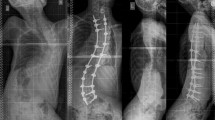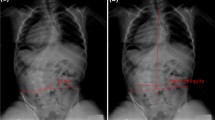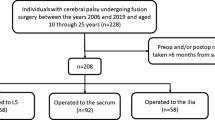Abstract
Purpose
This study aimed to determine the radiographic outcomes of patients with cerebral palsy (CP) who underwent posterior spinal fusion from T2/3 to L5 at two quaternary hospitals.
Methods
From January 2010 to January 2020, 167 non-ambulatory patients with CP scoliosis underwent posterior spinal fusion using pedicle screws from T2/3 to L5 in both centers, with a minimum of 2 years follow-up (FU). Radiological measurements and chart reviews were performed.
Results
A total of 106 patients aged 15.6 ± 0.4 years were included. None of the patients was lost to FU. All patients had significant correction of the Cobb angle (MC) and pelvic obliquity (PO), thoracic kyphosis (TK), and lumbar lordosis (LL), without loss of correction at the last FU (LFU). The mean values for preoperative, immediate postoperative, and LFU were MC 93.4°, 37.5°, and 42.8°; PO 25.8°, 9.9°, and 12.7°; TK 52.2°, 44.3°, and 45°; and LL − 40.9°, − 52.4°, and − 52.9°, respectively. Higher residual PO at LFU was associated with more severe MC and PO baselines, lower implant density, and an apex located at L3.
Conclusions
CP scoliosis and PO can be corrected, and this correction is maintained over time with posterior spinal fusion using pedicle screws, with L5 as the lowest instrumented vertebra. Larger preoperative MC and PO values associated with the apex at L3 appear to be related to residual PO. Comparative large-scale studies of patient-related clinical outcomes are required to determine whether this intervention is associated with improved surgical outcomes and reduced complication rates.
Level of evidence
IV.


Similar content being viewed by others
References
Jain A et al (2018) Caregiver perceptions and health-related quality-of-life changes in cerebral palsy patients after spinal arthrodesis. Spine (Phila Pa 1976) 43(15):1052–1056
Miller DJ et al (2020) Improving Health-related quality of life for patients with nonambulatory cerebral palsy: who stands to gain from scoliosis surgery? J Pediatr Orthop 40(3):e186–e192
Miyanji F et al (2018) Assessing the risk-benefit ratio of scoliosis surgery in cerebral palsy: surgery is worth it. J Bone Joint Surg Am 100(7):556–563
Toll BJ et al (2021) Risk factors for proximal junctional kyphosis following surgical deformity correction in pediatric neuromuscular scoliosis. Spine (Phila Pa 1976) 46(3):169–174
Vandendriessche E et al (2021) Complication rate after scoliosis surgery in children with cerebral palsy. Acta Orthop Belg 87(2):255–261
Yaszay B et al (2020) Major complications following surgical correction of spine deformity in 257 patients with cerebral palsy. Spine Deform 8(6):1305–1312
Furdock R, Luhmann SJ (2020) The value of preoperative labs in identifying “at-risk” patients for developing surgical site infections after pediatric neuromuscular spine deformity surgery. Spine Deform 8(3):517–522
Luhmann SJ, Furdock R (2019) Preoperative variables associated with respiratory complications after pediatric neuromuscular spine deformity surgery. Spine Deform 7(1):107–111
Matsumoto M et al (2018) Perioperative complications in posterior spinal fusion surgery for neuromuscular scoliosis. Spine Surg Relat Res 2(4):278–282
Strom SF et al (2022) Is it necessary to fuse to the pelvis when correcting scoliosis in cerebral palsy? World J Orthop 13(4):365–372
Li Y et al (2022) Pelvic fixation is not always necessary in children with cerebral palsy scoliosis treated with growth-friendly instrumentation. Spine Deform 10(4):925–932
Farshad M et al (2022) Pelvic fixation in surgical correction of neuromuscular scoliosis. N Am Spine Soc J 10:100123
Tsirikos AI, Mains E (2012) Surgical correction of spinal deformity in patients with cerebral palsy using pedicle screw instrumentation. J Spinal Disord Tech 25(7):401–408
Wu Z et al (2021) Iliac screw instrumentation to the pelvis in children with neuromuscular and syndromic scoliosis. No lateral connectors and respect sagittal balance. Spine Deform 9(4):1115–1123
Nielsen E et al (2019) Don’t you wish you had fused to the pelvis the first time: a comparison of reoperation rate and correction of pelvic obliquity. Spine (Phila Pa 1976) 44(8):E465–E469
Suresh KV et al (2021) Spinal fusion with sacral alar iliac pelvic fixation in severe neuromuscular scoliosis. JBJS Essent Surg Tech 11(3):4
Stiel N et al (2020) Pedicle screw instrumentation with or without pelvic fixation in neuromuscular scoliosis: outcome and complications in a series of 37 patients with a minimum 2-year follow-up. Surgeon 18(5):e7–e12
Tondevold N et al (2020) Should instrumented spinal fusion in nonambulatory children with neuromuscular scoliosis be extended to L5 or the pelvis? Bone Joint J 102-B(2):261–267
Nordon DG et al (2017) Correlation between the degree of correction of neuromuscular scoliosis and patient quality of life. Clinics (Sao Paulo) 72(2):71–80
Shrader MW et al (2018) Inter- and intraobserver reliability of pelvic obliquity measurement methods in patients with cerebral palsy. Spine Deform 6(3):257–262
Lonstein JE, Akbarnia A (1983) Operative treatment of spinal deformities in patients with cerebral palsy or mental retardation. An analysis of one hundred and seven cases. J Bone Joint Surg Am 65(1):43–55
Ilharreborde B et al (2020) Spinal sagittal alignment and head control in patients with cerebral palsy. J Child Orthop 14(1):17–23
Agha RA et al (2018) The PROCESS 2018 statement: updating consensus preferred reporting of CasE series in surgery (PROCESS) guidelines. Int J Surg 60:279–282
Schwab F et al (2015) The comprehensive anatomical spinal osteotomy classification. Neurosurgery 76(Suppl 1):S33-41
Willoughby KL et al (2022) Epidemiology of scoliosis in cerebral palsy: A population-based study at skeletal maturity. J Paediatr Child Health 58(2):295–301
Yoshida K et al (2018) Natural history of scoliosis in cerebral palsy and risk factors for progression of scoliosis. J Orthop Sci 23(4):649–652
Murphy RF, Mooney JF 3rd (2019) Current concepts in neuromuscular scoliosis. Curr Rev Musculoskelet Med 12(2):220–227
Loughenbury PR, Tsirikos AI (2022) Current concepts in the treatment of neuromuscular scoliosis: clinical assessment, treatment options, and surgical outcomes. Bone Jt Open 3(1):85–92
Cloake T, Gardner A (2016) The management of scoliosis in children with cerebral palsy: a review. J Spine Surg 2(4):299–309
Hasler C et al (2020) Spine deformities in patients with cerebral palsy; the role of the pelvis. J Child Orthop 14(1):9–16
Funk S et al (2016) Rigid instrumentation for neuromuscular scoliosis improves deformity correction without increasing complications. Spine (Phila Pa 1976) 41(1):46–52
Funding
The authors did not receive support from any organization for the submitted work.
Author information
Authors and Affiliations
Contributions
RAMC: made substantial contributions to the conception, design, analysis, major revisions and interpretation of data; drafted and critically revised the work, approved the version to be published, and agrees to be accountable for all aspects of the work. JL, ST, MH: made substantial contributions to the analysis, and revision and interpretation of data; drafted and revised the work, approved the version to be published, and agree to be accountable for all aspects of the work. ST, TE, MH, EB: revised the work, approved the version to be published, and agree to be accountable for all aspects of the work. TE: made substantial contributions to the analysis and interpretation of data and revised the manuscript. EB: made substantial contributions to the design, analysis, revision, and interpretation of data.
Corresponding author
Ethics declarations
Conflict of interest
The authors have no relevant financial or non-financial interests to disclose. The authors have no competing interests to declare relevant to the content of this article.
Ethics approval
Ethical approval was waived by the local Ethics Committee of Great Ormond Street Hospital under the number GOSH3034 in view of the retrospective nature of the study and all the procedures being performed were part of the routine care.
Additional information
Publisher's Note
Springer Nature remains neutral with regard to jurisdictional claims in published maps and institutional affiliations.
Rights and permissions
Springer Nature or its licensor (e.g. a society or other partner) holds exclusive rights to this article under a publishing agreement with the author(s) or other rightsholder(s); author self-archiving of the accepted manuscript version of this article is solely governed by the terms of such publishing agreement and applicable law.
About this article
Cite this article
Morales Ciancio, R.A., Lucas, J., Tucker, S. et al. Distal level in scoliosis surgery for non-ambulatory patients with cerebral palsy: is L5 an option? A case series study. Spine Deform 11, 1467–1475 (2023). https://doi.org/10.1007/s43390-023-00722-w
Received:
Accepted:
Published:
Issue Date:
DOI: https://doi.org/10.1007/s43390-023-00722-w




